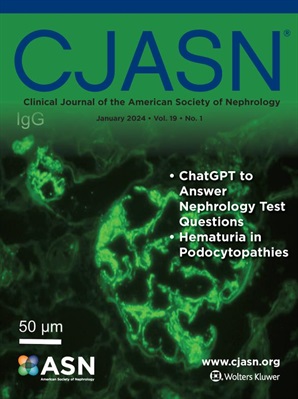Associations of abnormal fluid status, plasma sodium disorders, and low dialysate sodium with mortality in hemodialysis patients
IF 8.5
1区 医学
Q1 UROLOGY & NEPHROLOGY
Clinical Journal of the American Society of Nephrology
Pub Date : 2024-09-10
DOI:10.2215/cjn.0000000000000552
引用次数: 0
Abstract
The study followed 68,196 incident hemodialysis patients from 875 dialysis clinics in 25 countries over 10 years (2010-2020) investigating dose-response patterns between cumulative exposure time of fluid overload/depletion (measured by bioimpedance spectroscopy using the Fresenius Body Composition Monitor [BCM]), abnormal plasma sodium levels, low dialysate sodium, and all-cause mortality. We calculated time-varying cumulative exposure (in months) of relative fluid overload (any degree; >7% or severe; >13 or >15% in women or men, respectively) and fluid depletion (<-7%), hypo- or hypernatremia (sodium <135 or >145 mmol/L, respectively), low dialysate sodium (≤138 mmol/L), and estimated hazard ratios (HRs) for all-cause mortality using a multivariable Cox model. Results: Of 2,123,957 patient-months, 61% were spent in any degree of fluid overload, 4% in fluid depletion, 11% in hyponatremia, and 1% in hypernatremia. Any degree of fluid overload was associated with higher all-cause mortality (HR peak at 3.42 (95% confidence intervals: 3.12-3.75) relative to no exposure), and this association with all-cause mortality appeared to be stronger with severe fluid overload. The risk pattern associated with hyponatremia was approximately linear in the first four patient-months and then plateaued after the fourth patient-month. We did not observe effect modification between fluid overload and hyponatremia. Conclusion: Even mild fluid overload was associated with higher mortality in hemodialysis patients. Whether a more stringent fluid management results in clinical improvement requires further investigation. Copyright © 2024 by the American Society of Nephrology...血液透析患者体液状态异常、血浆钠紊乱和透析液钠过低与死亡率的关系
该研究对25个国家875家透析诊所的68196名血液透析患者进行了为期10年(2010-2020年)的跟踪调查,研究了体液超负荷/耗竭累积暴露时间(使用费森尤斯身体成分监测仪[BCM]通过生物阻抗光谱测量)、血浆钠水平异常、透析液钠过低和全因死亡率之间的剂量反应模式。我们计算了相对体液超负荷(任何程度;>7%或严重;女性或男性分别>13%或>15%)和体液耗竭(分别为145毫摩尔/升)、透析液钠过低(≤138毫摩尔/升)的时变累积暴露量(以月为单位),并使用多变量Cox模型估算了全因死亡率的危险比(HRs)。结果:在 2,123,957 个患者月中,61% 的患者处于任何程度的液体超负荷状态,4% 的患者处于液体耗竭状态,11% 的患者处于低钠血症状态,1% 的患者处于高钠血症状态。任何程度的体液超负荷都与较高的全因死亡率相关(相对于未接触体液超负荷,HR 峰值为 3.42(95% 置信区间:3.12-3.75)),而严重体液超负荷与全因死亡率的关系似乎更为密切。与低钠血症相关的风险模式在前四个患者月近似线性,在第四个患者月后趋于平稳。我们没有观察到液体超负荷和低钠血症之间的效应改变。结论:即使是轻微的液体超负荷也会导致血液透析患者的死亡率升高。更严格的液体管理是否能改善临床状况还需进一步研究。版权所有 © 2024 年美国肾脏病学会...
本文章由计算机程序翻译,如有差异,请以英文原文为准。
求助全文
约1分钟内获得全文
求助全文
来源期刊
CiteScore
12.20
自引率
3.10%
发文量
514
审稿时长
3-6 weeks
期刊介绍:
The Clinical Journal of the American Society of Nephrology strives to establish itself as the foremost authority in communicating and influencing advances in clinical nephrology by (1) swiftly and effectively disseminating pivotal developments in clinical and translational research in nephrology, encompassing innovations in research methods and care delivery; (2) providing context for these advances in relation to future research directions and patient care; and (3) becoming a key voice on issues with potential implications for the clinical practice of nephrology, particularly within the United States. Original manuscript topics cover a range of areas, including Acid/Base and Electrolyte Disorders, Acute Kidney Injury and ICU Nephrology, Chronic Kidney Disease, Clinical Nephrology, Cystic Kidney Disease, Diabetes and the Kidney, Genetics, Geriatric and Palliative Nephrology, Glomerular and Tubulointerstitial Diseases, Hypertension, Maintenance Dialysis, Mineral Metabolism, Nephrolithiasis, and Transplantation.
文献相关原料
| 公司名称 | 产品信息 | 采购帮参考价格 |
|---|

 求助内容:
求助内容: 应助结果提醒方式:
应助结果提醒方式:


